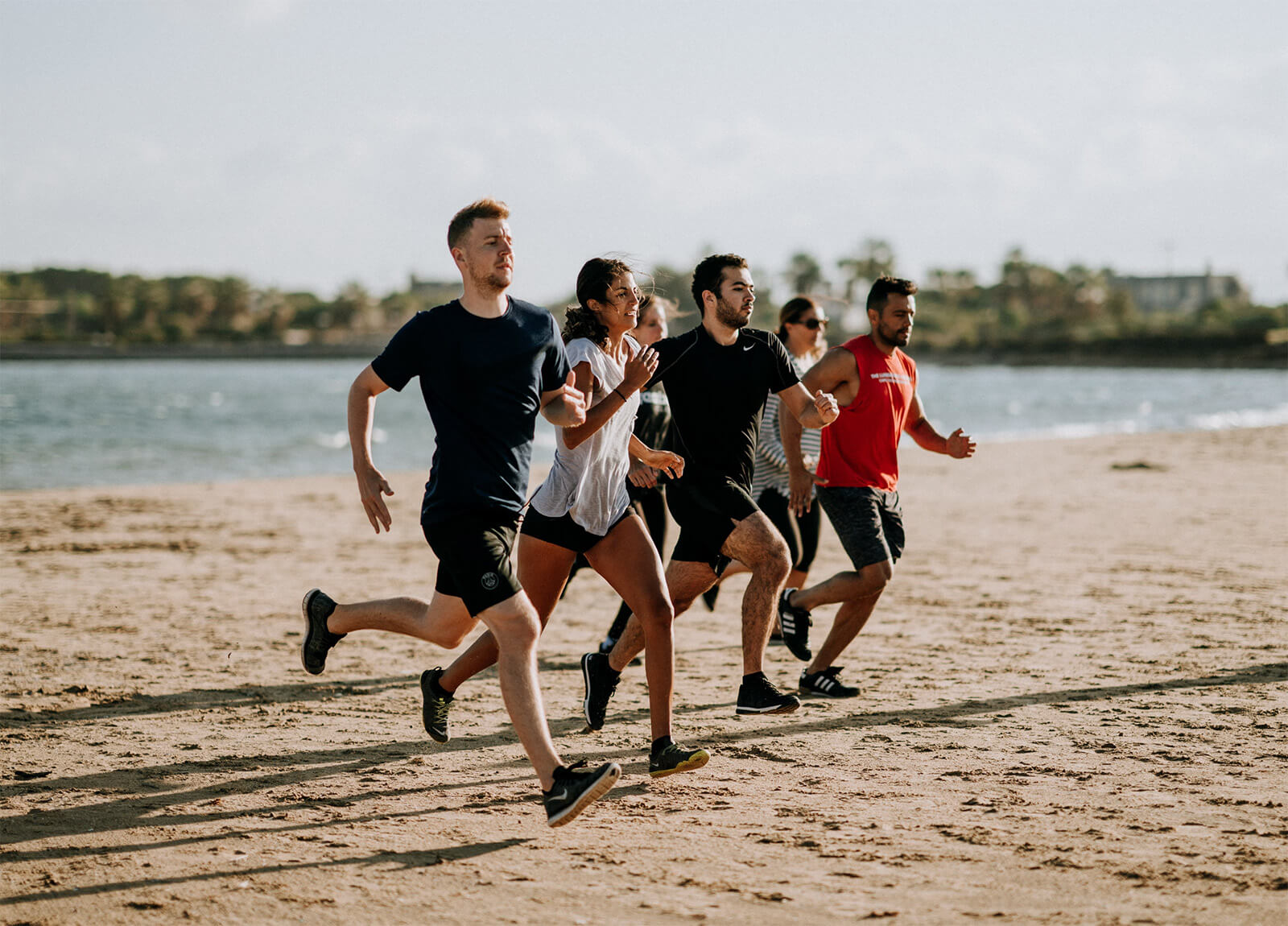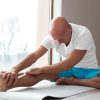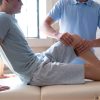This warm-up combines dynamic stretches, sport-specific movements for running and Australian Rules Football (AFL), and a Tabata-style cardio session. It prepares your muscles, improves flexibility, and elevates your heart rate for optimal performance.
1. Dynamic Stretches (5 Minutes)
Perform each movement for 30 seconds per side or 10–12 reps:
Leg Swings (Front-to-Back):
-
- Hold onto a wall or post for balance.
- Swing one leg forward and backward in a controlled motion.
- Switch legs after 30 seconds.
Hip Circles:
-
- Stand on one leg, lift the opposite knee, and draw large circles with it.
- Perform clockwise and counterclockwise movements, then switch legs.
Walking Lunges with Torso Twist:
-
- Step forward into a lunge position.
- Twist your torso towards the leading leg.
- Alternate legs as you walk forward.
Arm Swings (Across Chest and Overhead):
-
- Swing arms across your chest, then overhead and back.
- Perform the movements fluidly to loosen shoulders and chest.
High Knees (In Place):
-
- Jog on the spot, bringing your knees as high as possible.
- Keep your arms active by pumping them rhythmically.
2. Sport-Specific Movements (7 Minutes)
For Running (3.5 Minutes)
A-Skips (30 seconds):
-
- Skip forward, driving your knees high and emphasizing a quick toe-off.
- Swing your arms naturally with each skip.
Bounding (30 seconds):
-
- Perform exaggerated running strides, focusing on height and distance.
Butt Kicks (30 seconds):
-
- Jog forward, bringing your heels to your glutes.
Strides (2 sets of 20 meters):
-
- Run at 70–80% effort for 20 meters, focusing on relaxed, efficient form.
- Walk back and repeat.
For AFL (3.5 Minutes):
Shuttle Runs (30 seconds):
-
- Sprint between two markers placed 10 meters apart.
Side Shuffles (30 seconds):
-
- Stay low in an athletic stance and shuffle side-to-side for agility.
Handball Simulation (30 seconds):
-
- Perform mock handballing with quick, controlled arm movements while jogging in place.
Kicking Simulation (2 sets of 10 kicks):
-
- Perform gentle kicks, focusing on technique and follow-through.
3. Tabata-Style Cardio (8 Minutes)
The Tabata protocol is 20 seconds of effort, 10 seconds rest for 4 minutes per round. Perform the following exercises for 2 rounds.
Round 1:
- High Knees (20 seconds effort, 10 seconds rest)
- Burpees (20 seconds effort, 10 seconds rest)
- Jump Squats (20 seconds effort, 10 seconds rest)
- Mountain Climbers (20 seconds effort, 10 seconds rest)
Round 2:
- Lateral Bounds (Skaters): Jump side-to-side, landing on one leg at a time.
- Push-Up to Shoulder Tap: Perform a push-up, then tap each shoulder alternately.
- Fast Feet: Run in place with quick, small steps.
- Jump Lunges: Alternate legs while jumping from one lunge to the next.
Cool-Down Exercises (Optional, 2–3 Minutes)
End with gentle static stretches, focusing on your calves, quads, hamstrings, and hip flexors to promote recovery. This warm-up primes your body for running and AFL, reduces injury risk, and gets you mentally prepared to perform your best!
A proper cool-down is essential for easing your body back to a resting state, improving flexibility, and reducing soreness after activity. Below are detailed instructions for cool-down exercises that target key muscle groups used during running and AFL.
1. Standing Hamstring Stretch (30–60 seconds per leg)
Target Area: Hamstrings
- Stand upright and step one foot forward with your heel on the ground and toes pointing up.
- Keep the front leg straight and the back knee slightly bent.
- Hinge at your hips, lowering your torso towards the front leg while keeping your back flat.
- Hold the stretch when you feel a mild pull at the back of your thigh.
- Switch legs.
2. Quadriceps Stretch (30–60 seconds per leg)
Target Area: Front of thighs
- Stand tall and grab your right ankle with your right hand, pulling your heel towards your glutes.
- Keep your knees close together and push your hips slightly forward to deepen the stretch.
- If needed, hold onto a wall or chair for balance.
- Switch legs.
3. Calf Stretch (30–60 seconds per leg)
Target Area: Calves
- Stand facing a wall and place both hands on it at shoulder height.
- Step one foot back, keeping the back leg straight and the front knee bent.
- Press your back heel into the ground while leaning into the wall.
- You should feel the stretch along the back of your lower leg.
- Switch legs.
4. Hip Flexor Stretch (30–60 seconds per leg)
Target Area: Hip flexors
- Kneel on your right knee and place your left foot flat on the ground in front of you (90-degree angle at the knee).
- Shift your weight forward slightly, keeping your torso upright, until you feel a stretch at the front of your right hip.
- Optional: Raise your right arm overhead and lean slightly to the left for a deeper stretch.
- Switch legs.
5. Child’s Pose (30–60 seconds)
Target Area: Lower back and hips
- Kneel on the ground and sit back onto your heels.
- Extend your arms forward and lower your chest towards the floor.
- Relax your forehead on the ground and take deep breaths, feeling the stretch along your spine and hips.
6. Seated Forward Fold (30–60 seconds)
Target Area: Hamstrings and lower back
- Sit on the ground with your legs extended straight in front of you.
- Reach forward with both hands, aiming to touch your toes or shins.
- Keep your back flat and avoid bouncing; just hold the stretch.
7. Side-Lying Spinal Twist (30 seconds per side)
Target Area: Spine and glutes
- Lie on your back and bring your right knee towards your chest.
- Drop your right knee across your body to the left side while keeping your shoulders flat on the ground.
- Extend your right arm to the side and look towards it for a deeper spinal twist.
- Switch sides.
8. Neck Stretch (15–20 seconds per side)
Target Area: Neck and shoulders
- Sit or stand upright.
- Gently tilt your head to the right, bringing your ear towards your shoulder.
- Place your right hand on the side of your head for a light stretch (do not pull hard).
- Repeat on the left side.
Cool-Down Tips
- Focus on slow, deep breathing during each stretch to enhance relaxation.
- Avoid bouncing or jerking movements to prevent strain.
- Hold each stretch to the point of mild tension, not pain.
By incorporating these stretches into your cool-down, you’ll promote muscle recovery, reduce soreness, and prepare your body for your next activity!





